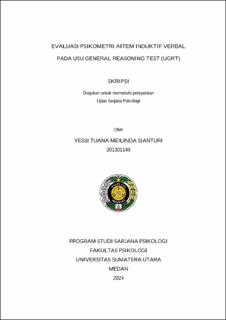| dc.description.abstract | This study aims to evaluate the Verbal Inductive items on the USU General Reasoning Test (UGRT), specifically the Verbal Analogies (IV 1) and Word Meanings (IV 2) subtests. The method used is descriptive quantitative analysis using secondary data obtained from the P3M Faculty of Psychology, Universitas Sumatera Utara. The sample consisted of 824 UGRT participants, aged 15-60 years, divided into 4 sets (A, B, C, and D). Data were analyzed using the Rasch model, and the results showed that: (1) The Verbal Analogies (IV 1) and Word Meanings (IV 2) subtests in each set exhibited unidimensionality above 20%, indicating that the test meets the criteria. (2) There were 3 Verbal Inductive items identified as unfit based on criteria 0.5 < MNSQ < 1.5; -2.0 < ZSTD < 2.0; and 0.4 < Pt Mean Corr < 0.85. These items were item 5 from set C Verbal Analogies, item 3 from set A Word Meanings, and item 3 from set D Word Meanings. (3) Person reliability for Verbal Analogies in sets A, B, C, and D were 0.31, 0.06, 0.19, and 0.33, respectively. For Word Meanings, person reliability in sets A, B, C, and D were 0.37, 0.42, 0.36, and 0.22, respectively. It can be concluded that participant response consistency across all Verbal Inductive sets was weak. (4) Reliability coefficients based on item reliability values indicated that all Verbal Analogies (IV 1) and Word Meanings (IV 2) items had excellent reliability, ranging from 0.93 to 0.98. | en_US |


